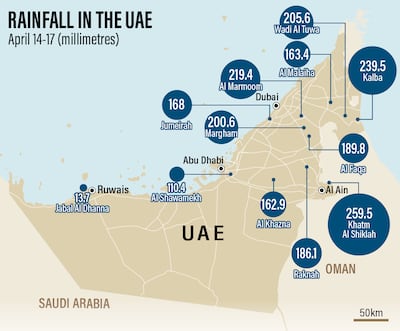Cloud Seeding Did Not Take Place During Torrential Rain, UAE Weather Bureau Says

The UAE’s weather bureau has said no cloud seeding missions took place during Tuesday’s torrential rain.
A representative for the National Centre of Meteorology confirmed to sources on Wednesday that its seeding planes had not approached the storm that saw waves of heavy rain inundating areas of the country.
Many people took to social media to speculate that the country’s cloud seeding programme—a process that attempts to coax more rain from a cloud – was responsible for the deluge.
“The NCM didn’t conduct any seeding operations during this event,” it said in a statement.
“One of the basic principles of cloud seeding is that you have to target clouds in their early stages before they rain. If you have a severe thunderstorm situation, then it is too late to conduct any seeding operations.
“We take the safety of our people, pilots and aircraft very seriously. NCM doesn’t conduct cloud seeding operations during extreme weather events.”
Some reports on Tuesday attributed comments to an NCM forecaster stating seeding had taken place.
However, the bureau said planes had been in the air in the days leading up to the storm but they had only “taken samples” and had not been seeding clouds.

The NCM oversees the seeding programme and has previously stated several times that it is too dangerous to use seeding planes during severe weather.
It has also previously stated that, during bouts of unsettled weather when seeding does take place, the process would not create thunderstorms.
“Some say we are responsible for storms. We are not responsible for this,” an NCM forecaster previously told sources.
“Aircraft do not go inside storm clouds if they are strong or dangerous,” the forecaster said. “All we do is try to strengthen some clouds.”
The NCM, meanwhile, had warned over the weekend of unstable conditions that were expected to persist until Wednesday. It had been predicted that the worst of the weather would hit on Monday and Tuesday.
A forecaster told sources on Wednesday that ferocious rains that hit the country were caused by a warm and humid air mass from the Arabian Sea that met a cold air mass from the north-west.
“This makes for instability,” the forecaster said. “And this caused towering convective clouds over the UAE, starting in the west and moving gradually to Abu Dhabi, Al Ain and then north.”
The rains came in waves over the country, hitting a torrential peak on Tuesday that brought chaos to parts of the UAE, flooding homes, submerging cars, stranding residents and delaying flights.
The country has been lashed by more rain since Sunday than it would expect to receive over several decades, official figures reveal.
The last of the rain only finished on Wednesday but the system is now moving east.
“The country is set to experience more stable weather tonight,” the forecaster said.
“It was a very strong episode. I had not seen this type of occurrence in a long time.”
The UAE’s cloud-seeding programme started in the 1990s and is based in Al Ain.
When experts see a cloud that is suitable, a small plane is dispatched from Al Ain to “seed” the cloud, typically with salt flares that naturally attract water.
The aim is to enhance rain, not to create it. It is hard to quantify exactly how much rain falls as a result of the process.
The NCM, which oversees the operation, has said more research is needed to determine its true impact.




